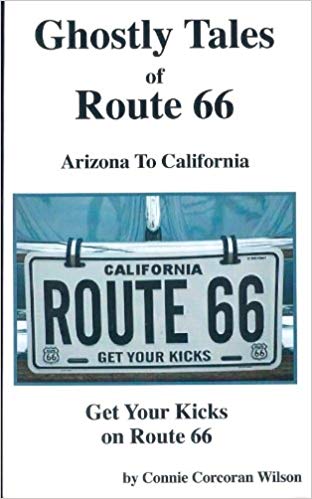By CONNIE WILSON (Quixote Press; 2009)
Here’s one for you history buffs: a collection of fact based ghost stories from various parts of the legendary Route 66. As the title indicates, the tales are situated between Arkansas and Arizona (a subsequent volume promises to explore Route 66 from Arizona to California). Overall Ghostly Tales of Route 66 is very much in the mold of quite a few similarly themed anthologies past and present (see TRUE GHOST STORIES OF THE AMERICAN SOUTHWEST), but it has a highly quirky, idiosyncratic air.
The approach taken by author Connie Wilson is unique, combining a personal travelogue (complete with photos of the author at many of the locations cited) with a historical and folkloric compendium. It’s profusely illustrated with photos, some of the vintage variety and others that look like they were taken yesterday.
The book commences with a quick history of the “Mother Road,” a highway that began with the Fort Smith to California Road and culminated in Route 66. The first story is an account of Isaac Parker, the hanging judge of Fort Smith, Arkansas, and his sentencing of the half-breed Cherokee Bill for the killing of a deputy. Before his execution Cherokee Bill vowed to haunt the judge and the town…and apparently kept his vow!
From there we move into Oklahoma. Here we learn that, due in part to the wrangling of Oklahoma Highway Commissioner Cyrus Avery in the 1920s, “more of Route 66 runs through the state of Oklahoma than through any other state.” There follows, unpredictably enough, an apparently true recollection of the author’s own 2008 encounter with a ghost at Fort El Reno, a military depot turned research laboratory. It was there that one Major Konat committed suicide in the 1930s after his wife left him, and Connie Wilson believes she might have felt the Major’s ghost tap her on the shoulder.
Next up is another historical chronicle: Clark Young was a Buffalo (or black) Soldier of the 10th U.S. Cavalry who died at Fort El Reno, and whose ghost (and that of his horse!) apparently haunts the Fort cemetery. Also afoot is the spirit of William Stockwell, an unjustly incarcerated soldier who died in the 1880s from strychnine poisoning, and whose cries can still be heard in the Fort El Reno guardhouse.
Texas is the setting for the following tale, which happens to be the most outrageous of them all. It concerns Lady Brynad, a WWII-era librarian of McLean, TX who murdered a German POW being held at a nearby internment camp; she was in love with the POW but snapped upon learning he had a family back home. After killing the man the author claims Miss Brynad chopped him up and cannibalized his remains. Her ghost, of course, is said to still be hanging around together with that of her daughter, who partook of the banquet.
Amarillo, Texas is where a woman in a white dress is sometimes glimpsed and laughing voices are heard, apparently from the participants of a 1928 love triangle that resulted in a double murder and suicide. Another Route 66 Amarillo landmark is the Cadillac Ranch, where ten Cadillacs are buried nose down in eight-foot holes. The ghostly presence here is an Indian boy accosted at the site in 1984 who was never seen or heard from (alive, that is!) again.
The book concludes in New Mexico—specifically Tucumcari, a town some say got its name from a Shakespearean tale of love and violence that concluded with an Indian chief mourning the deaths of the tragic lovers Tocom and Kari before committing suicide. The chief’s final words can supposedly still be heard in the area.
Whether you buy into the author’s claims of ghostly presences or not, GHOSTLY TALES OF ROUTE 66 is an enjoyable trip down one of America’s most iconic routes. Plus, at 142 profusely illustrated pages, it shouldn’t take more than an hour to read.

